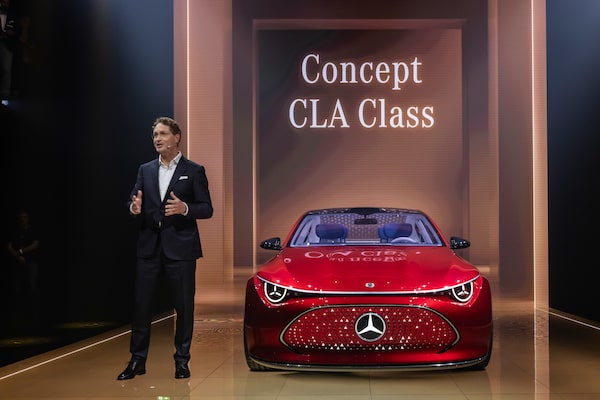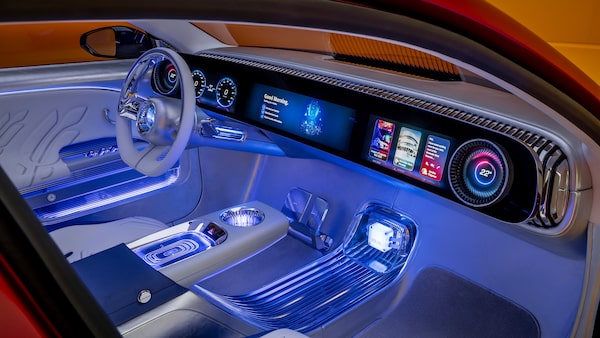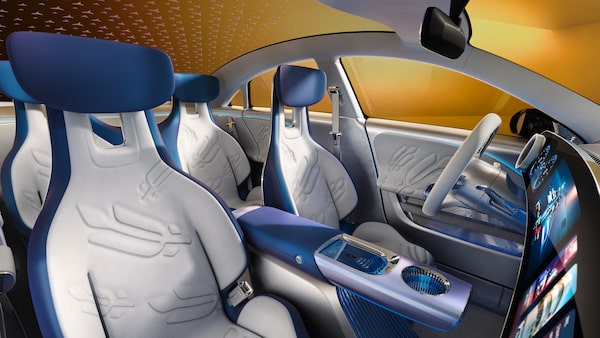
Mercedes-Benz Group AG CEO Ola Kaellenius unveils the forerunner to a whole new model family, the Concept CLA Class, at the Mercedes-Benz Pavilion before the 2023 Munich auto show.Mercedes-Benz AG Communications & Marketing/Courtesy of manufacturer
It may only be a concept, but if the new CLA sedan that Mercedes-Benz showed here before the Munich auto show is any indication, the future is already here.
A few years ago, automotive journalists like myself would smile gently at concept vehicles, knowing that their fancy gull-wing doors, digital side mirrors and 22-inch wheels would never make production. Seat covers made from recycled papyrus would be replaced for real-world buyers by cost-effective fabric. Claims of speed and fuel consumption would have to be experienced to be believed.
The new CLA, however, will be the new all-electric entry-level vehicle for Mercedes-Benz, and its astonishing technology is suddenly realistic. It’s scheduled to debut as a production vehicle before the end of next year. There is no suggested pricing yet.
The claims are remarkable, but achievable: a range of 750 kilometres, based on an average energy consumption of 12 kilowatt-hours per 100 kilometres. An efficiency in that energy consumption of 93 per cent, from the power provided by the battery to the power used by the wheels. And 15 minutes of charging at a Level 3 DC fast charger, at 250 kilowatts, will put 400 kilometres of range back in the battery.

The vehicle claims to have a range of 750 kilometres, based on an average energy consumption of 12 kilowatt-hours per 100 kilometres.Mercedes-Benz AG - Global Commun/Courtesy of manufacturer
The CLA will be the first vehicle built on the new Mercedes-Benz Modular Architecture platform, which will later include a station wagon and two SUVs. It will also use an entirely new operating system, called MB.OS, to integrate its software and hardware and provide better personalization for its driver and passengers.
It’s based on the Vision EQXX that was shown at last year’s Consumer Electronics Show in Las Vegas, though its numbers fall a little short of the targets for that vehicle. That prototype achieved a drive of more than 1,000 kilometres on a single charge, with an average energy consumption of 10 kilowatt-hours per 100 kilometres. Still, the CLA is the entry-level electric car. Perhaps another EV might come closer to those targets, but it will be a struggle.
“We literally said to our engineers, ‘go to town’,” said Ola Kaellenius, chief executive officer of Mercedes-Benz, of the EQXX. “It has, of course, an extreme aerodynamic shape, very little rolling resistance from its tires and a very lean set of other energy-consumer users. So I applaud the technical effort by the team to build that prototype, but then when you transport that into the real world, with all the safety features and all the other features, then you can carry a lot of it over but not all of it.
“So 12 kilowatt-hours per 100 kilometres for a vehicle that is more than 4.7 metres long, with every single feature you’d expect from a Mercedes – which is a lot – is a quite phenomenal number.”
As for the drivetrain’s efficiency of 93 per cent, “you’re reaching the limits of physics, basically,” said Markus Schaefer, chief technology officer for Mercedes-Benz. “The e-motor itself is like 98 per cent, and you can go only to a hundred. I would say it’s pretty much maxed out.”

The interior trim uses recycled paper and hemp, the door pockets feature vegan silk, while the seats are upholstered with sustainably produced and processed leather.Mercedes-Benz AG - Global Commun/Courtesy of manufacturer
Other than range and consumption, there was no talk of performance at the concept car’s reveal, on a flashy stage the evening before the auto show opened to the media. Mercedes recognizes that future customers are less attracted by zero-to-100 than they are to driving range, and top speed now just seems irrelevant. This vehicle is all about sustainability and decarbonization, to satisfy Mercedes’ corporate goal of net carbon neutrality by 2039 for all its new vehicles, from production to final disposal. It’s an ambitious target, and they’re starting with the CLA.
The floor mats are made from bamboo, the interior trim uses recycled paper and hemp, the door pockets feature vegan silk, while the seats are upholstered with sustainably produced and processed leather that apparently satisfies the Animal Welfare Committee. We’ve heard all this stuff before from premium brands, but it’s only now that we’re actually seeing it in production vehicles.
One of the biggest challenges for any electric car that claims to be environmentally conscious is the battery, and Mercedes says it’s developed a new unit that will come with a choice of two different chemistries: the less-expensive one will be lithium-ion phosphate and quite compact, while the more costly version will feature “an anode design with silicon-oxide content” for optimal energy density. That will be the battery that can provide the fastest charging, and the 750 kilometres of range.
The EV uses 800-volt architecture, like the Porsche Taycan, the Hyundai Ioniq 5 and 6 and the Kia EV6. It combines a 175-kilowatt motor with a two-speed transmission, and comes with a heat pump that can use the outside air to warm the cabin, even at sub-zero temperatures, not just air off the drivetrain. The electronic drive unit – that’s what they call the motor these days – uses almost no heavy rare earth materials, and the battery’s cell production and cathode production are both carbon neutral. Mercedes says this reduces the carbon footprint of the cells by 40 per cent.
But maybe the best feature among this plethora of developments is the Child Presence Detection system, designed to protect children from being accidentally left in a car on a hot day. Its sensors are so sensitive that they can detect the breathing of a sleeping baby and also the presence of an adult in the passenger seat. If the computer senses that a child is alone in the parked and locked car, it will message the driver’s cellphone to alert them. But not only that: it will monitor the car’s cabin temperature and sound an alarm to bystanders if it gets too hot. It will start up the air-conditioning to cool things down. It will send messages to every smartphone registered with the car, and if none of that works, it will notify the Mercedes SOS call centre and emergency services. Now that’s something we should have had long ago.
The writer was a guest of the automaker. Content was not subject to approval.
Shopping for a new car? Check out the Globe Drive Build and Price Tool to see the latest discounts, rebates and rates on new cars, trucks and SUVs. Click here to get your price.
 Mark Richardson
Mark Richardson